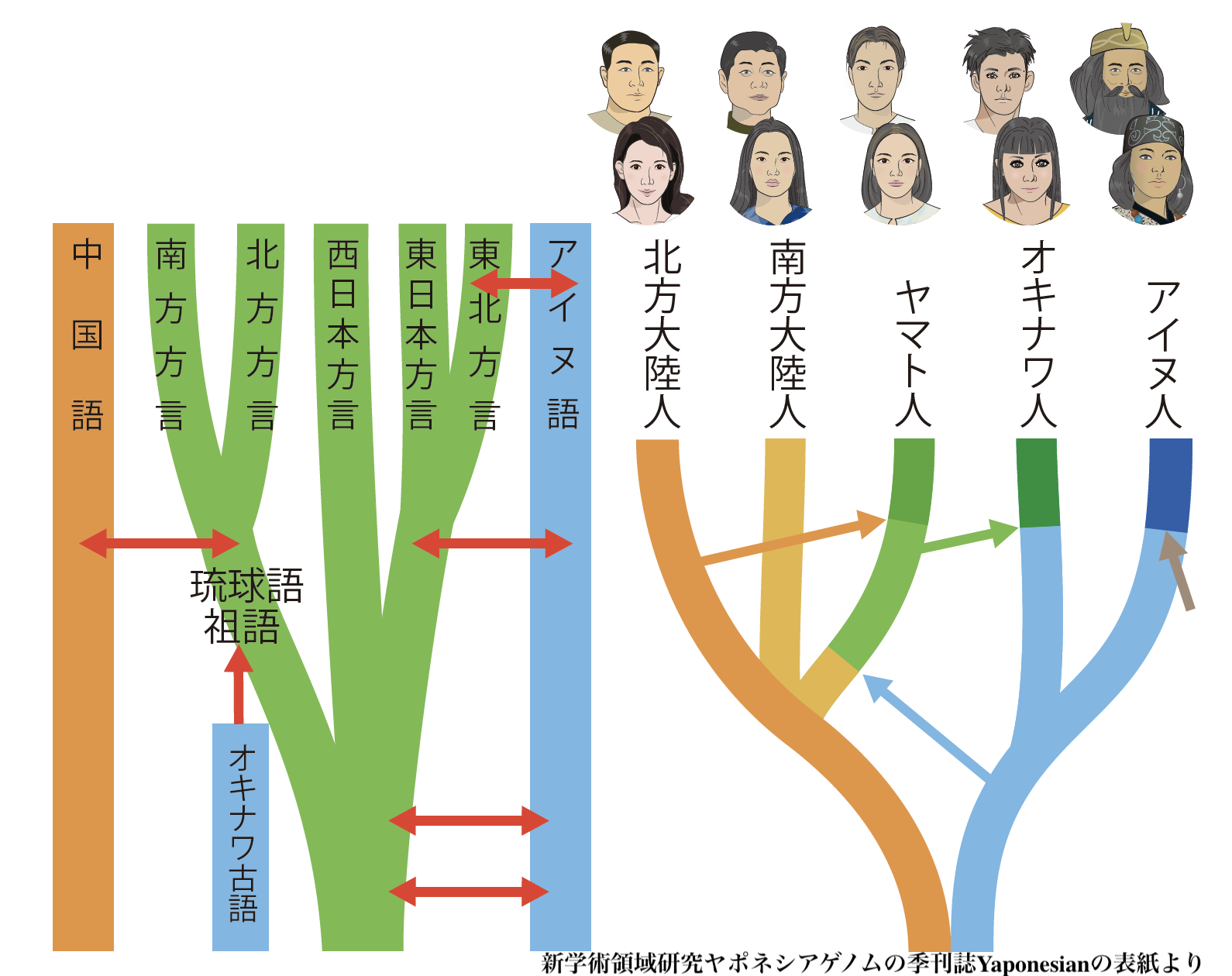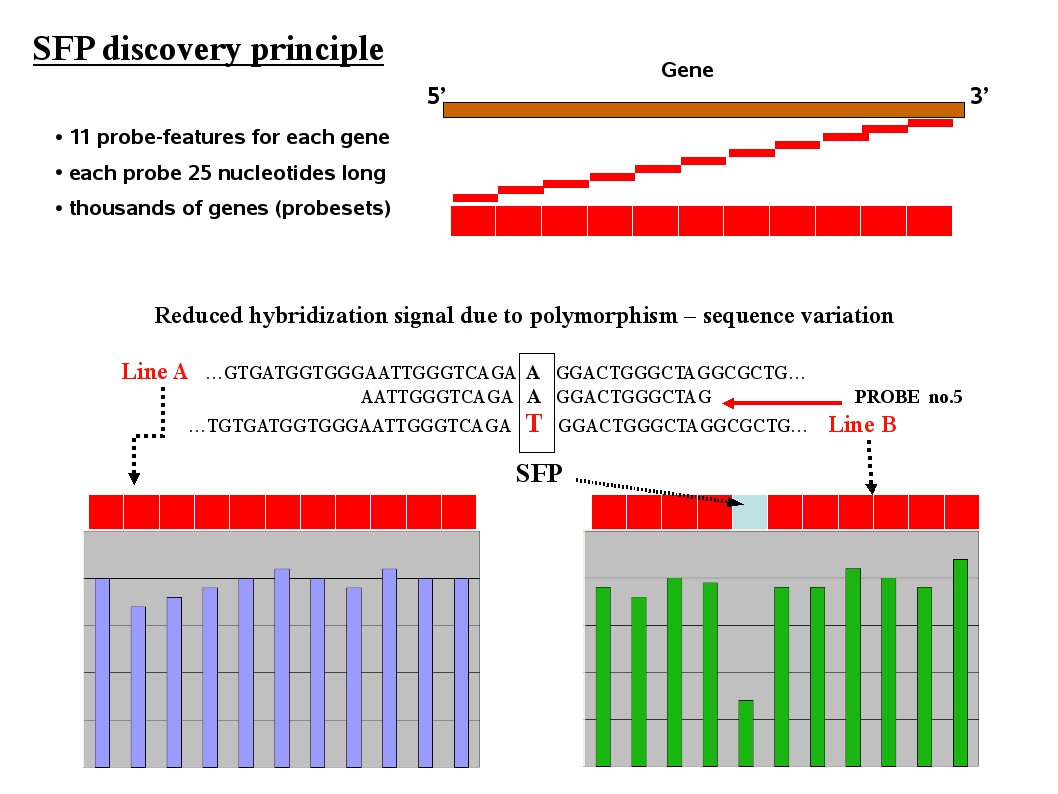
人種という概念を使わずに人間の集団を定義できるか?
How do we define a certain human group
without using racial concepts?
☆
DNAの遺伝的多型マーカー(genetic polymorphism marker)を分析すれば、DNAレベルでのヒトの集団を定義できる。
| A genetic marker
is a gene or DNA sequence with a known location on a chromosome that
can be used to identify individuals or species. It can be described as
a variation (which may arise due to mutation or alteration in the
genomic loci) that can be observed. A genetic marker may be a short DNA
sequence, such as a sequence surrounding a single base-pair change
(single nucleotide polymorphism, SNP), or a long one, like
minisatellites. |
遺
伝マーカーとは、染色体上の位置がわかっている遺伝子やDNA配列のことで、個体や種の同定に用いることができる。遺伝マーカーは、観察可能な変異(ゲノ
ム遺伝子座の変異や変化によって生じる可能性がある)として記述することができる。遺伝マーカーは、一塩基対の変化を囲む配列(一塩基多型、SNP)のよ
うな短いDNA配列である場合もあれば、ミニサテライトのような長い配列である場合もある。 |
| Background For many years, gene mapping was limited to identifying organisms by traditional phenotypes markers. This included genes that encoded easily observable characteristics such as blood types or seed shapes. The insufficient number of these types of characteristics in several organisms limited the mapping efforts that could be done. This prompted the development of gene markers which could identify genetic characteristics that are not readily observable in organisms (such as protein variation).[1] |
背景 長年にわたり、遺伝子マッピングは伝統的な表現型マーカーによって生物を同定することに限られていた。これには血液型や種子の形など、容易に観察できる特 徴をコードする遺伝子が含まれていた。いくつかの生物では、このようなタイプの特徴の数が不十分であったため、マッピングの取り組みが制限されていた。こ のため、生物では容易に観察できない遺伝的特徴(タンパク質の変異など)を同定できる遺伝子マーカーの開発が促された[1]。 |
Types SFP discovery principle for gene probing Some commonly used types of genetic markers are: RFLP (or Restriction fragment length polymorphism) SSLP (or Simple sequence length polymorphism) AFLP (or Amplified fragment length polymorphism) RAPD (or Random amplification of polymorphic DNA) VNTR (or Variable number tandem repeat) SSCP (or Single-strand conformation polymorphism) SSR Microsatellite polymorphism, (or Simple sequence repeat)[2] SNP (or Single nucleotide polymorphism) STR (or Short tandem repeat) SFP (or Single feature polymorphism) DArT (or Diversity Arrays Technology) RAD markers (or Restriction site associated DNA markers) STS (using Sequence-tagged sites)[2] Molecular genetic markers can be divided into two classes: a) biochemical markers which detect variation at the gene product level such as changes in proteins and amino acids and b) molecular markers which detect variation at the DNA level such as nucleotide changes: deletion, duplication, inversion and/or insertion. Markers can exhibit two modes of inheritance, i.e. dominant/recessive or co-dominant. If the genetic pattern of homo-zygotes can be distinguished from that of hetero-zygotes, then a marker is said to be co-dominant. Generally co-dominant markers are more informative than the dominant markers.[3] |
タイプ 遺伝子プロービングのSFP発見原理 一般的に使用される遺伝子マーカーには、以下のような種類があります: RFLP(または制限断片長多型) SSLP(単純配列長多型) AFLP(増幅断片長多型) RAPD(ランダム多型DNA増幅法) VNTR(可変長タンデムリピート) SSCP(一本鎖コンフォメーション多型) SSRマイクロサテライト多型(または単純配列反復)[2]。 SNP(または一塩基多型) STR(ショートタンデムリピート) SFP(または一特徴多型) DArT(ダイバーシティアレイテクノロジー) RADマーカー(または制限部位関連DNAマーカー) STS(Sequence-tagged sitesを使用)[2]。 分子遺伝マーカーは、a) タンパク質やアミノ酸の変化など遺伝子産物レベルでの変異を検出する生化学マーカーと、b) 欠失、重複、逆位、挿入などのヌクレオチド変化などDNAレベルでの変異を検出する分子マーカーの2つのクラスに分けられる。マーカーは優性/劣性または 共優性という2つの遺伝様式を示すことができる。ホモ接合体の遺伝パターンがヘテロ接合体の遺伝パターンと区別できる場合、そのマーカーは共優性であると いわれる。一般に、共優性マーカーは優性マーカーよりも情報量が多い[3]。 |
| ses Genetic markers can be used to study the relationship between an inherited disease and its genetic cause (for example, a particular mutation of a gene that results in a defective protein). It is known that pieces of DNA that lie near each other on a chromosome tend to be inherited together. This property enables the use of a marker, which can then be used to determine the precise inheritance pattern of the gene that has not yet been exactly localized. Genetic markers are employed in genealogical DNA testing for genetic genealogy to determine genetic distance between individuals or populations. Uniparental markers (on mitochondrial or Y chromosomal DNA) are studied for assessing maternal or paternal lineages. Autosomal markers are used for all ancestry. Genetic markers have to be easily identifiable, associated with a specific locus, and highly polymorphic, because homozygotes do not provide any information. Detection of the marker can be direct by RNA sequencing, or indirect using allozymes. Some of the methods used to study the genome or phylogenetics are RFLP, AFLP, RAPD, SSR. They can be used to create genetic maps of whatever organism is being studied. There was a debate over what the transmissible agent of CTVT (canine transmissible venereal tumor) was. Many researchers hypothesized that virus like particles were responsible for transforming the cell, while others thought that the cell itself was able to infect other canines as an allograft. With the aid of genetic markers, researchers were able to provide conclusive evidence that the cancerous tumor cell evolved into a transmissible parasite. Furthermore, molecular genetic markers were used to resolve the issue of natural transmission, the breed of origin (phylogenetics), and the age of the canine tumor.[4] Genetic markers have also been used to measure the genomic response to selection in livestock. Natural and artificial selection leads to a change in the genetic makeup of the cell. The presence of different alleles due to a distorted segregation at the genetic markers is indicative of the difference between selected and non-selected livestock.[5] |
用途 遺伝マーカーは、遺伝性疾患とその遺伝的原因(例えば、欠陥タンパク質をもたらす遺伝子の特定の変異)との関係を調べるのに用いることができる。染色体上 で互いに近接するDNA断片は、一緒に遺伝する傾向があることが知られている。この性質を利用してマーカーを用いれば、まだ正確な位置が特定されていない 遺伝子の正確な遺伝パターンを特定することができる。 遺伝子マーカーは、遺伝的系譜のDNA検査において、個体間または集団間の遺伝的距離を決定するために使用される。単親マーカー(ミトコンドリアまたはY染色体DNA上)は、母系または父系を評価するために研究されます。常染色体マーカーはすべての家系に使用される。 遺伝子マーカーは容易に識別可能で、特定の遺伝子座に関連し、多型性が高くなければならない。マーカーの検出には、RNA配列決定による直接的な方法と、アロザイムを用いた間接的な方法がある。 ゲノムや系統の研究に用いられる方法には、RFLP、AFLP、RAPD、SSRなどがある。これらは、研究対象の生物の遺伝地図を作成するために使用できる。 CTVT(犬伝染性性病性腫瘍)の伝染因子が何であるかについては議論があった。多くの研究者は、ウイルスのような粒子が細胞を形質転換させるという仮説 を立てたが、他の研究者は、細胞自体が同種移植片として他のイヌに感染できると考えた。遺伝子マーカーの助けを借りて、研究者たちは癌性腫瘍細胞が感染性 の寄生虫に進化したという決定的な証拠を示すことができた。さらに、分子遺伝マーカーは、自然感染、原産品種(系統学)、イヌの腫瘍の年齢の問題を解決す るために使用された[4]。 遺伝マーカーはまた、家畜の選択に対するゲノムの反応を測定するためにも用いられてきた。自然淘汰および人為的淘汰は、細胞の遺伝子構成に変化をもたら す。遺伝マーカーにおける分離の歪みによる異なる対立遺伝子の存在は、選択された家畜とそうでない家畜の違いを示している[5]。 |
| Marker gene Molecular marker DNA marking Eukaryotic chromosome fine structure Repeated sequence (DNA) |
マーカー遺伝子 分子マーカー DNAマーキング 真核染色体の微細構造 繰り返し配列(DNA) |
| https://en.wikipedia.org/wiki/Genetic_marker |
|
| ★人種はないが、人間の集団の間には「差異がある」と主張される、根拠のレトリック |
|
| Human beings are genetically identical 99.5% of the time. However, the human genome contains 3 billion base pairs, which means that every individual may differ from every other individual by 15 million loci (0.5% of 3 billion). The rhetoric is that since they differ by 15 million loci, it is only natural that they should differ in human populations. If it is a difference in intelligence or moral disposition, it can be said to be a reintroduction of the Lombroso theory. | 「人間は遺伝的に99.5%同一である。だがしかし、ヒトゲノムには 30 億塩基対があるため、どの個体でも 1,500 万座位 (30 億の 0.5%) で他の個体と異なる可能性があることを意味する」というもの。 1,500 万座位も違うのだから、人間集団において違いがでてくるのは当然というレトリックである。それが、知能の違いや道徳的性向のちがいだとすれば、それは、ロンブローゾ学説の再来とも言える。 |
リ ンク
文 献
そ の他の情報
Copyleft, CC, Mitzub'ixi Quq Chi'j, 1996-2099
☆
 ☆
☆